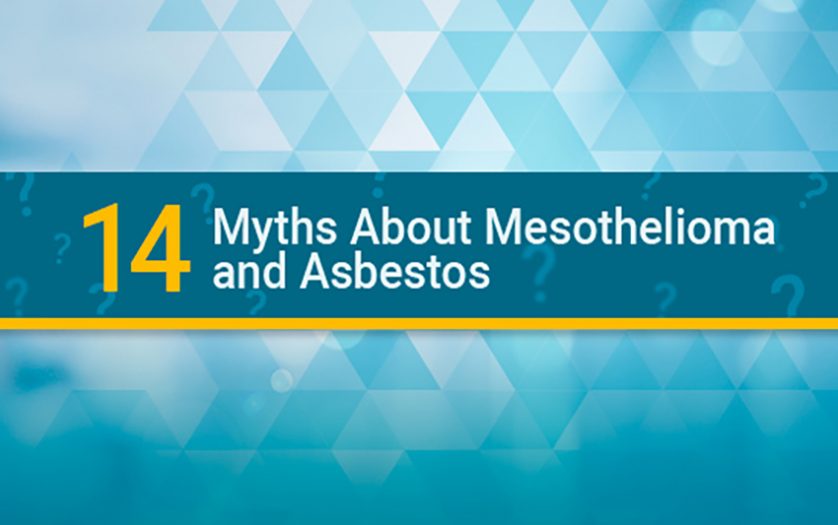14 Myths about Mesothelioma and Asbestos

Unfortunately, there are quite a few misconceptions regarding mesothelioma, the rare and aggressive disease caused by asbestos exposure. Some people ask, “Is mesothelioma contagious?” Others believe the disease is linked to smoking.
These incorrect assessments range from how people develop mesothelioma to where the disease forms within the body. Other mesothelioma myths include the demographics affected by mesothelioma, the amount of asbestos exposure needed to develop the sickness and the legality of using the substance in the United States.
Let’s put an end to the most common myths right here and now.
Myth No. 1: Smoking Is Linked to Mesothelioma
Smoking is not linked to mesothelioma. The act does not cause or increase your risk of developing the disease. The disease forms along the mesothelium, which is a lining that covers three specific areas of your body: the lungs (pleura), abdominal cavity (peritoneum) and heart (pericardium). Inhaling harmful smoke causes lung cancer specifically. While mesothelioma can spread to and affect one or both of the lungs, it does not form in the lung.
Myth No. 2: Mesothelioma Is a Lung Cancer
Pleural mesothelioma shares the closest resemblance to lung cancer, but even this form of mesothelioma is not lung cancer. The disease forms in the pleura, which is a protective membrane that separates the lungs from your chest wall. Pleural mesothelioma can metastasize to the lungs but does not form there, which excludes it from being considered lung cancer.
Since mesothelioma and lung cancer share similar traits — and can appear in the same areas of the body — some doctors may misdiagnose mesothelioma as lung cancer.
Myth No. 3: Mesothelioma Only Affects the Lungs
Mesothelioma affects much more than just the lungs. Peritoneal mesothelioma forms in the lining around the abdominal cavity, which includes many organs. Your diaphragm, heart, appendix, intestines, colon, pancreas, gallbladder, liver and testicles may also be at risk when mesothelioma forms.
Myth No. 4: Mesothelioma Is Contagious
Mesothelioma is not contagious. It cannot spread from human contact or germs. The only scientifically proven cause of mesothelioma is exposure to the mineral known as asbestos. Therefore, if you are a mesothelioma patient, you do not need to worry about coughing and giving the disease to others.
Myth No. 5: Mesothelioma Only Affects the Elderly
Mesothelioma is not limited to a specific age — or any demographic. However, the disease does have higher incidence rates in older people. The latency period, which is the amount of time a disease takes to develop, is between 20 and 50 years for mesothelioma. Therefore, the disease doesn’t manifest until people get older.
Myth No. 6: You Must Work With Asbestos to Develop Mesothelioma
Occupational exposure to asbestos is the most likely way to develop mesothelioma. However, there are other avenues to ingesting or inhaling the mineral.
You could live near an asbestos mine — such as the one in Libby, Montana — or asbestos processing plant. These instances are known as environmental exposure.
You also could have consistent interaction with someone who worked with asbestos. Maybe you were the wife of an insulation worker and regularly washed their work clothes. Asbestos fibers can stick to shirts or pants, putting anyone who touches the clothes at risk. This is an example of secondhand exposure.
Another possibility is exposure due to using cosmetics or beauty products. Even household appliances such as hair dryers included asbestos for many years.
Myth No. 7: The Larger the Amount of Your Asbestos Exposure, the More Likely a Person Is to Get Mesothelioma
There is no proven correlation between the quantity of asbestos exposure and the risk of developing mesothelioma. A person who works one day in a construction or insulation job — both industries which relied on asbestos for much of the 20th century — could find out 30 or 40 years later they have the disease. The only variable is whether or not asbestos fibers entered your body, were not expelled, lodged into the mesothelium and caused cellular mutation.
Myth No. 8: Asbestos Is Banned in the United States
Asbestos is not banned in the United States. As of June 2019, only the state of New Jersey has banned the sale and use of asbestos in products — and the state’s government only recently passed the law. Politicians and activist groups have tried to get asbestos banned in the U.S. but the Environmental Protection Agency only has restrictions in place currently.
Myth No. 9: Companies That Produced and Sold Asbestos Didn’t Know of the Health Risks
For some companies, maybe this is true. For many of them? They knew.
Not only did they know of asbestos’ health risks, but they also hid the information from their workers and the general public for many years. They put millions of lives at risk, caused thousands of deaths and emotionally scarred many American families. They did wrong, from both a moral and legal standpoint.
Myth No. 10: Mesothelioma Only Affects Men
Mesothelioma does affect men more than women, but that’s largely because men are more likely to work in jobs that include asbestos. Most people who have pleural mesothelioma are men, but the gender divide for peritoneal mesothelioma is close to a 50-50 split.
Myth No. 11: Mesothelioma Is Untreatable and Always Has a Poor Prognosis
Mesothelioma is treatable. The options include surgery, chemotherapy and radiation. The recommended strategy involves a combination of two or all three, which is called a multimodal treatment approach. Surgery is the most effective treatment method as it removes most or all of the tumors from the body.
While mesothelioma is aggressive, the prognosis isn’t always discouraging. Depending on the type of the disease and stage, some patients live up to five years following their diagnosis. Early detection usually leads to a longer life expectancy — because the tumors are more likely to be removed when the cancer has yet to spread far from the point of origin.
In short, there is hope if you have mesothelioma. Treatment methods are improving, more specialists are emerging and additional information is made available with each year.
Myth No. 12: Mesothelioma Lawsuits Are Expensive for the Patient or Patient’s Family
If mesothelioma lawsuits are expensive for anyone, then it’s the company or companies responsible. The patient is the victim in these cases — and should not need to pay upfront costs or high amounts to receive representation.
The top national mesothelioma law firms work on a contingency basis, meaning they only receive a percentage of the payout at the end. If there is no payout, then the firm receives nothing. Therefore, neither the patient (in personal injury lawsuits) nor the patient’s surviving loved ones (in wrongful death cases) need to dip into savings or incur massive debt to take legal action.
Myth No. 13: Mesothelioma Compensation Requires a Stressful Legal Battle
Not always. Not even most of the time. In fact, most mesothelioma cases settle long before they ever reach trial. Have you ever seen movies and television shows that depict lawsuits as lengthy court battles? Yeah, those hardly ever happen for mesothelioma cases.
The companies at fault will likely want to avoid expensive legal battles, which means they’ll try to settle before trial. Settlements help the victim receive compensation immediately — and avoid a lengthy, stressful appeals process.
Another avenue for mesothelioma compensation is an asbestos trust fund. These are court-ordered funds that asbestos-involved companies had to create if they filed for bankruptcy. These funds ensure future mesothelioma victims receive compensation to cover lost wages from no longer being able to work, medical costs for treatment and other financial strains.
Myth No. 14: Mesothelioma Patients Must Find Treatment and Legal Help on Their Own
This statement may be the least truthful one of the bunch. There are plenty of resources available to mesothelioma patients. In fact, many people dedicate their lives to helping the victims of asbestos exposure through the medical and legal aspects of their disease.







